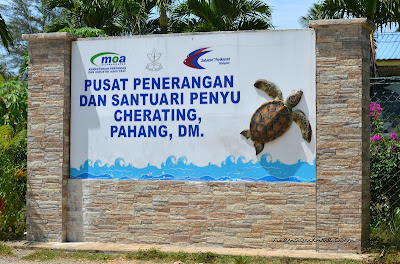WELCOME TO TURTLE SANCTUARY CHERATING PAHANG

Cherating Turtle Sanctuary is located just beside Asia's first
Club Med in Cherating, Pahang. This centre was established in the year 1972 as
a turtle hatchery in an effort to protect the endanger species in particular
the Leatherback Turtle. It was opened to the public in June, 1 1998.
Situated at the Chendor Beach
or Pantai Chendor, this centre helps to ensure the survival of the turtles that
land here to lay eggs during the months from April to August. You are allowed
to come here during the night and the centre will alert you if there are
turtles that come up the shore to lay eggs. It also acts as an information
centre to educate the public about turtles and the need to protect them.
INFORMATION
Tuesdays to Sundays : 9am to 1pm, 2pm to 5:30pm
(The lunch break
is from 1pm to 2pm. The centre is closed on Mondays.)
Fridays: 9am to 12:00pm, 3pm to 5:30pm
(The
centre is closed from 12pm to 3pm for Friday prayer)
CONTACT NUMBER :
TEL: (6)09-5819087
FAX: (6)-09-5523482
EMAIL:
penyuphg@tm.net.my
ACTIVITIES
"Visit to turtle egg hatchery"
"The release of turtle children"
"Exhibition tour (static) illumination and video presentation"
"A night turtle watching program on the beach cherating as far as 3.5KM"
"Research program"
ABOUT
Cherating Turtle Sanctuary is located just beside Asia's first
Club Med in Cherating, Pahang. This centre was established in the year 1972 as
a turtle hatchery in an effort to protect the endanger species in particular
the Leatherback Turtle. It was opened to the public in June, 1 1998.
Situated at the Chendor Beach
or Pantai Chendor, this centre helps to ensure the survival of the turtles that
land here to lay eggs during the months from April to August. You are allowed
to come here during the night and the centre will alert you if there are
turtles that come up the shore to lay eggs. It also acts as an information
centre to educate the public about turtles and the need to protect them.
In total, there are 7 species of marine turtles in the world and 4
of these species land and lay their eggs on Malaysian beaches. They are the Leatherback
Turtle, Green Turtle, Hawksbill Turtle and Olive Ridley Turtle.
Over the years, the number of
Leatherback turtles that come to the shore of Malaysia has dwindled and you
will not be able to see any of them coming here now. The reasons are because of
the poachers who came to take the eggs away for commercial reason, abused of
the turtles from the public and the pollution
"FOUR SPECIES OF
SEA TURTLES THAT NEST ON THE BEACHES IN MALAYSIA SEA"
Leatherback Turtle
(Dermochelys coriaces)
Green Turtle
(Chelonia Mydas)
Hawksbill
(Eretmochelys Imbricata)
Olive Ridley Turtle (Lepidocgelys Olivacea)
Loggerhead
Kemp's Ridley
Flatback
Besides acting as a place where you can wait at the benches in the
night, the Cherating Turtle Sanctuary also has many exhibits for you to
explore. There are information on the different types of turtles, their
habitat, food and the location where they can be found in Malaysia and in
particular, the state of Pahang. There are also graphs and statistics on the
number of turtles that come here.
It was reported recently that
the number of green turtles that came here has increased from 160 for the year
2006 to 288 from Jan to Aug 2007. This shows that the turtles conservation
programme is bearing fruit and should be continued.
Apart from information on
turtles, you will be able to see many exotic and nice sea shells that are on
displayed at the main exhibition hall. Big corals are also aplenty here .
DO YOU KNOW THE DIFFERENCES BETWEEN TURTLE AND TORTOISE ??
Definition
|
A Tortoise is a
reptile from the Chelonian family and dwells well on land.
|
A Turtle is a reptile
from the Chelonian family and dwells well in the water.
|
Definition
|
Found mostly in Asia
and Africa but some species exist in Americas too.
|
Africa, America
|
Shape of the shell
|
Mostly large dome
shaped shells (with bumps on the top in some species).
|
Mostly flat,
streamlined shells
|
Weight of the shell
|
The shells are heavier
|
Generally light-weight
shell.
|
Limbs
|
Feet are short and
sturdy with bent legs.
|
Webbed feet with long
claws.
|
Diet
|
Most are herbivores,
but some species prefer live food
|
Eats fruits, veggies,
leafy vegetation and meat, hence they are omnivores.
|
Birth
|
Tortoise hatchlings
move from their nest to the mothers burrow soon after birth.
|
Turtle hatchlings stay
in their nest on their own for 90-120 days.
|
Lifespan
|
80-150 years. The
longest living Tortoise is 326 years
|
20-40 years. The
oldest was 86 years.
|
APPENDIX
Tourism Student of Politeknik Metro Kuantan






































